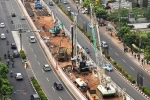This article has been translated by PwC Indonesia as part of our Indonesia Infrastructure News Service. PwC Indonesia has not checked the accuracy of, and accepts no responsibility for the content.
Investor Daily - Giant sea wall diminati investor
23 January 2024
By Totok Subagus, Tri Listyorini, and Heru Febrianto
Jakarta, ID – The construction of the giant sea wall in the northern part of Java is imperative to safeguard citizens and economic zones predominantly located in the northern part of Java from tidal flooding. The megaproject that has been recognised as a national strategic project (PSN) is predicted to cost around Rp600 trillion to Rp700 trillion and has attracted several investors.
The giant sea wall is a structure that will be built along the coast to separate land and water. Based on the website of the Regional Infrastructure Development Agency (BPIW) of the Public Works and Housing (PUPR) Ministry, the sea wall will be constructed to prevent erosion and damages from sea waves.
According to data from the PUPR Ministry, the northern coast of Java spans five provinces and encompasses 28 regencies/cities. The 1,800 km of coastline, home to a population of 43 million, includes 200 thousand fishermen and fish farmers, contributing to a fish production of 2.5 million tonnes valued at Rp45 trillion. However, the northern coast faces challenges such as land subsidence at an average rate of 1-2 cm per year and tidal flooding ranging from 5 to 200 cm. These issues have resulted in economic losses, exemplified by a Rp29.1 billion loss in mangrove-related economic activities in Pemalang Regency in 2020.
Coordinating Minister for Economic Affairs Airlangga Hartarto said that, in reality, the construction of the sea wall project has previously commenced. However, it was not integrated. “So, we want to integrate it from the west to the centre. This requires cooperation from all parties from the KKP (Ministry of Marine Affairs and Fisheries), the ATR (Ministry of Agrarian and Spatial Planning), and the regional government,” Airlangga said last weekend.
Airlangga emphasises the significance of this policy in safeguarding citizens from the threats of climate change. He notes, "The impact on citizens and economic zones along the northern coast is substantial, given that a majority of our economic zones are situated there, making them susceptible to tidal flooding,” he added.
Executing the project requires substantial funding. Nonetheless, he mentioned that several investors have expressed interest in participating in the project.
“There are several investors who want to invest in the project’s construction. The project is planned to be constructed using the public-private partnership (PPP) scheme,” Airlangga.
Airlangga ensured that the construction of the project would not disrupt the ecosystem as ecologic studies have been conducted. “So, environmental issues have been prioritised. Moreover, the giant sea wall has doors for water [to go through], so it will not disrupt the ecosystem for mangroves or fishes,” Airlangga said.
Additionally, Airlangga highlighted that the task force responsible for constructing the giant sea wall has been deliberated within the Economic Ministry. He emphasised the necessity for collaboration among all parties to address the issue of land subsidence.
Meanwhile, the Marine Affairs and Fisheries Ministry stated that they would supervise the spatial planning process for the giant sea wall along the northern coast of Java. The Marine Affairs and Fisheries Ministry is preventing a conflict from happening between the policies and strategies that have been set in Government Regulation Number 32 of 2019 on Marine Spatial Plan and Presidential Regulation Number 3 of 2022 on Zoning Plan of Inter-region Area of Java Sea.
“The Marine Affairs and Fisheries Ministry will supervise the spatial planning process for the giant sea wall,” Special Assistant to Marine Affairs and Fisheries Minister in the field of Media and Public Communication Doni Ismanto said in his statement to Investor Daily in Jakarta on Monday (22/1/2024).
The giant sea wall construction has an excellent purpose, which is to prevent tidal flooding along the northern coast of Java. According to Doni, the giant sea wall is tightly related to one of the strategies for a blue economy in Indonesia, which is to improve the management of marine and coastal assets. Hence, the Marine Affairs and Fisheries Ministry will encourage the construction of the giant sea wall to balance the ecological, economic, and social aspects so that the ecosystem along the coast could be connected to the marine ecosystem and people could benefit from the giant sea wall construction continuously. The Marine Affairs and Fisheries Ministry is obligated to maintain the continuous function of coastal and marine ecosystems as they might be affected by the giant sea wall construction. The aspects they need to maintain include the functions of the mangrove ecosystem as a safeguard from threats to the coast, marine biota, and food.
Doni Ismanto explained that the Marine Affairs and Fisheries Ministry saw ecology as the commander. Hence, the Marine Affairs and Fisheries Ministry is encouraging the construction plan of the giant sea wall along the northern coast of Java to be carried out carefully and comprehensively by considering ecological sustainability, not only the economic aspect.
“The strategy offered by the Marine Affairs and Fisheries Ministry to safeguard and protect the northern coast of Java from various potential threats is a non-structural strategy, which is to prepare various laws and regulations on geotextile, hybrid engineering, mangrove planting, and sea walls,” Doni said.
In accordance with the applicable laws and regulations, the Marine Affairs and Fisheries Ministry is obligated to provide an approval letter on the suitability of marine spatial utilisation (KKPRL) and a reclamation implementation permit (IPR) for the giant sea wall. Hence, the Marine Affairs and Fisheries Ministry will also supervise the compliance of the giant sea wall construction permit holder in carrying out the construction. “The supervision process is preceded by control activities regarding the KKPRL to see if there are any violations in the implementation,” Doni added.
The suggestion to construct a giant sea wall in Jakarta and reclaim islands was delivered during the period of Jakarta Governor Fauzi Bowo in 2010. Initially, the giant sea wall was going to be constructed between 2020-2030 with the groundbreaking carried out in 2014. The construction was planned to start from Jakarta to the northern coast of Java.
Water Resources Director General of the PUPR Ministry Bob Arthur Lambogia reported that dry dams have been constructed in Ciawi and Sukamahi in Bogor Regency to manage flooding in the upstream area of Ciliwung River, and these were completed in 2022. These dams are expected to decrease flooding along Ciliwung River by 11%. Additionally, normalisation efforts have been carried out in the middle area of Ciliwung River, covering a distance of 16.9 km, leaving 16.3 km yet to be addressed.
Besides that, according to him, a waterway tunnel has been constructed in Ciliwung River to control flooding in the middle part towards the eastern floodway with a capacity of 66.3 cubic metres per second. The construction has been completed in 2023.
In the downstream area, the construction of Ancol Sentiong pump was completed in 2023. It can reduce flooding in seven districts reaching 879 hectares, namely Pademangan District, Kemayoran District, Tanjung Priok District, Johar Baru District, Senen District, Cempaka Putih District, and Matraman District.
“The pump is the largest pump that we have built with a capacity of five times 10 cubic metres per second. Its function is to flush sediments in Sentiong River to Kali Item,” Bob stated to the media in Jakarta recently.
He also explained that, from 2014 to 2019, 13 km of sea dikes and estuaries were constructed by the central government, Jakarta Provincial Government, and the private sector. So, there are still 25 km of coastline that are still categorised as critical as they have not been addressed.
As of 2023, the PUPR Ministry has constructed 8,278 km of sea dikes. Meanwhile, in Fiscal Year 2024, the PUPR Ministry and Jakarta Provincial Government are working on to construct 1,664 km of sea dikes.
“The construction of the giant sea wall is a last option if land subsidence continues to occur massively,” he said.
According to Bob, the government has also implemented a flood control concept called Jakarta Bay Coast Stage B. The Open Sea Dike variant will be implemented for 2030 to 2050 and the Closed Sea Dike variant will be implemented after 2050. The Open Sea Dike variant is expected to reduce the height of waves by 80% to 1.3 metres. Meanwhile, the Closed Sea Dike variant will establish a retention reservoir reaching 4,241 ha.
Next article: PT KAI increases operational capacity


















